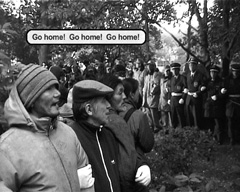Public Blue
(“Kansai koen: Public Blue”) JAPAN, GERMANY / 2007 / Japanese, English / Color / Video / 70 min
JAPAN, GERMANY / 2007 / Japanese, English / Color / Video / 70 min
Director, Photography, Sound, Editing, Producer: Anke Haarmann [AHA]
Photography: Hex, Marc Kramer, Adrian Mengay
Narrators: Anke Haarmann, Hex, Yuka Hofmann
Translation: Hex, Yuka Hofmann
Source: Anke Haarmann [AHA]
Homeless people in the Kansai region hold demonstrations with supporters after the government forcibly removes them from the parks of Osaka in 2006. Drawing on statements made by Fukuzawa Yukichi and Maruyama Masao, the film speculates on conceptions of “the park,” “public,” “conflict,” “social order,” and “freedom” in Japan. By attempting to define the “homeless” living under blue plastic sheets in public spaces, it questions the government’s actions in its own unique way. The well-thought-out, playful framing offers excellent analysis of a very “Japanese” issue, and reminds us of various other cases of exclusion imposed by the authorities in Japanese society today.
[Director’s Statement] Everywhere in the parks and on the river banks in Osaka you can see blue tents or barracks covered with blue plastic tarps—scattered throughout the park area, or lined up in rows, or gathered to form small communities. The term “homeless” doesn’t adequately describe the situation of these nojukusha, as they call themselves in the Kansai region—the campers in the rough. The nojukusha are the inhabitants of the parks. They are the squatters of the public places. But just as Japanese society has traditionally had little knowledge or appreciation of public places as public forums, likewise the homeless people who live in those spaces are disrespected.
The video essay Public Blue was produced in collaboration with nojukusha and with activists in Osaka. As a documentary, it follows their path to self-understanding and political action. As a visual essay it sketches the Japanese conceptions of the public and the political, as well as notions of “inside” and “outside” in Japanese society.
With the looming threat of evictions of homeless tents from parks in 2006 and at the request of those involved, this project was started in 2006 without a budget and with only a simple camera in hand. Police and city workers finally executed the eviction, but now the documentary is used in Osaka as a tool against new evictions of nojukusha, and it has become a vehicle of articulation for those who live on the outside of Japanese society.
 Anke Haarmann [AHA]
Anke Haarmann [AHA]
Anke Haarmann lives in Hamburg and Berlin, Germany. She is an artist, filmmaker, and philosopher using [AHA] to label her work, [AHA] meaning “Anke Haarmann in collaboration with . . .” To realize Public Blue she worked in collaboration with Sasayan-san, Nakanishi-san, Fujii-san, Tachibana-san, Tanabe-san, Nishitani-san, Ojo-san, Noma-san, the Kamagasaki Patrol, the Kamagasaki Medical Liaison Council, Hex, Adrian Mengay, Marc Kramer, Yuka Hofman, and others. Anke Haarmann has studied philosophy, literature, anthropology, and fine arts, and holds a PhD in philosophy. Her work has mostly been shown in art spaces as she works with different media such as video, photography, the Internet, illustration, and installation. Public Blue is also presented as an installation in Germany. She presented her video works at the Kassel Documentary Film and Video Festival 2006 and globale07 in Berlin. |
